手持式合金分析仪操作规程(中英文)
手持式合金分析仪的操作步骤 分析仪如何操作
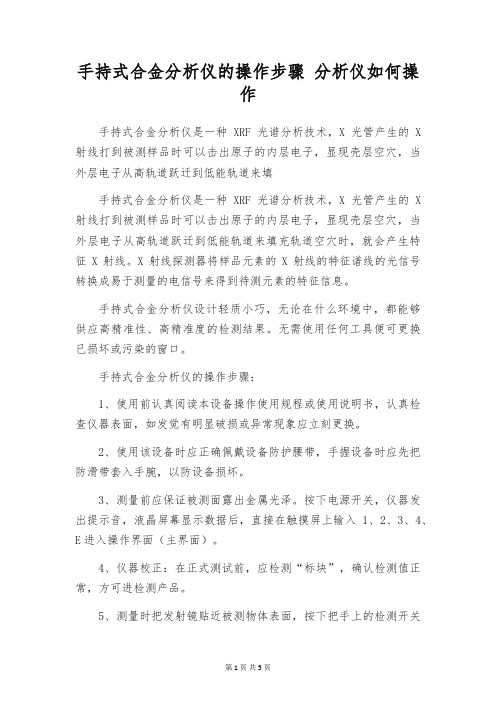
手持式合金分析仪的操作步骤分析仪如何操作手持式合金分析仪是一种XRF光谱分析技术,X光管产生的X 射线打到被测样品时可以击出原子的内层电子,显现壳层空穴,当外层电子从高轨道跃迁到低能轨道来填手持式合金分析仪是一种XRF光谱分析技术,X光管产生的X 射线打到被测样品时可以击出原子的内层电子,显现壳层空穴,当外层电子从高轨道跃迁到低能轨道来填充轨道空穴时,就会产生特征X射线。
X射线探测器将样品元素的X射线的特征谱线的光信号转换成易于测量的电信号来得到待测元素的特征信息。
手持式合金分析仪设计轻质小巧,无论在什么环境中,都能够供应高精准性、高精准度的检测结果。
无需使用任何工具便可更换已损坏或污染的窗口。
手持式合金分析仪的操作步骤:1、使用前认真阅读本设备操作使用规程或使用说明书,认真检查仪器表面,如发觉有明显破损或异常现象应立刻更换。
2、使用该设备时应正确佩戴设备防护腰带,手握设备时应先把防滑带套入手腕,以防设备损坏。
3、测量前应保证被测面露出金属光泽。
按下电源开关,仪器发出提示音,液晶屏幕显示数据后,直接在触摸屏上输入1、2、3、4、E进入操作界面(主界面)。
4、仪器校正:在正式测试前,应检测“标块”,确认检测值正常,方可进检测产品。
5、测量时把发射镜贴近被测物体表面,按下把手上的检测开关按钮,此时工作提示灯闪亮测量开始,待仪器发出提示音测量结束。
6、按“▼”/“▲”键翻看检测数据。
连续检测请则再次按下把手上的检测开关按钮。
退出检测界面按“←”回到主界面。
7、测量完毕后长按电源开关,关机,并将设备放置在防水设备箱内。
—专业分析仪器服务平台,试验室仪器设备交易网,仪器行业专业网络宣扬媒体。
相关热词:等离子清洗机,反应釜,旋转蒸发仪,高精度温湿度计,露点仪,高效液相色谱仪价格,霉菌试验箱,跌落试验台,离子色谱仪价格,噪声计,高压灭菌器,集菌仪,接地电阻测试仪型号,柱温箱,旋涡混合仪,电热套,场强仪万能材料试验机价格,洗瓶机,匀浆机,耐候试验箱,熔融指数仪,透射电子显微镜。
手持金属分析仪安全操作及保养规程

手持金属分析仪安全操作及保养规程手持金属分析仪是一种精密仪器,用于快速检测分析金属成分。
为了保证分析结果的准确性和仪器的长期使用,需要注意安全操作和定期保养。
本文将介绍手持金属分析仪的安全操作和保养规程。
安全操作规程1. 环境要求手持金属分析仪需要在清洁、干燥、密闭、无风场的环境下操作,确保分析结果准确性。
2. 仪器安装1.按照说明书正确安装仪器和电源,并确保所有仪器附件齐全。
2.将仪器置于水平平稳的表面上,且不要受到强烈的震动。
3.确保通风良好,避免仪器遭遇直射阳光和高湿度环境。
3. 样品准备1.样品表面应清洁干燥,杂质不得影响分析结果。
2.确保样品温度在5~30℃,避免过高的温度损坏仪器。
3.对于特殊样品,需事先试验,以保证分析结果的准确性。
4. 操作步骤1.开机前将手持金属分析仪准确指向样品,确保激光扫描透过试样多次以获取准确结果。
2.样品分析时,确保手持金属分析仪与样品表面距离合适,避免造成伤害或损坏。
3.操作过程中不要将仪器撞击、摔落等造成物理损伤。
4.严禁在手持金属分析仪的镜头、物镜等部位上涂抹清洗剂或化学试剂。
5.分析过程中不要过于频繁的采集数据,以防数据误差的扩大。
6.操作完毕后,先关闭仪器的激光扫描功能,再关机和断电。
5. 注意事项1.避免手持金属分析仪和电磁辐射源重叠使用,以防影响检测精度和稳定性。
2.镜头部分要小心维护,擦拭时须使用专用的擦拭布,不要用手直接接触。
3.分析仪使用过程中,要防潮,防晒,防震,防尘。
4.在外部方位要注意降低仪器受碰撞、磁场干扰及抗震能力。
5.不要强行拆卸或修理手持金属分析仪,以免影响仪器性能和检测精度。
保养规程1. 整机保养1.定期检查仪器有无变形、磨损等现象。
2.定期对仪器外壳、电缆、插头等进行清洁,使用清洁酒精等清洁剂擦拭。
3.定期检查螺丝等连接部位是否松动,确保仪器固定稳定。
2. 镜头保养1.定期检查镜头表面有无污垢和划痕,并及时擦拭。
2.不能在镜头表面上使用有害的溶剂,如丙酮、酒精等。
手持合金分析仪怎样进行操作

手持合金分析仪怎样进行操作合金分析仪是专门用于分析金属材料成分的一种设备。
它可以通过检测金属样品中的各种元素,来确定材料的合金成分以及材料的分类等信息。
手持合金分析仪是一种便携式的分析仪器,操作简单、使用方便,在现场分析工作中广泛应用。
下面我们来了解一下手持合金分析仪的操作步骤。
步骤一:准备工作首先,使用前需要对手持合金分析仪进行检查和维护。
检查仪器的电缆、探头、电池等设备是否完整并处于良好状态。
如果有任何破损或损坏,应及时更换。
同时,还需准备好样品,并将样品放置在干净的台面上。
步骤二:开机并进行校准手持合金分析仪在使用前需要进行标定和校准。
首先,需要通过按下开机键来启动仪器,并在屏幕上等待出现分析仪的主界面。
然后,进入校准界面,进行校准设定。
按照仪器说明书的要求,在校准模式下,选择合适的校准模板,进行校准设定。
在对参考标准进行校准后,手持合金分析仪就可以开始进行分析工作。
步骤三:选择分析模板针对不同的样品类别,需要选择对应的分析模板。
手持合金分析仪一般提供多种模板可选,选择对应的模板可以更准确地分析出样品成分。
步骤四:分析操作进入分析模式后,放置手持合金分析仪探头在样品上,按下开始按钮,手持合金分析仪会开始检测并输出数据。
整个分析过程不需要额外的化学处理或显微镜观察,操作非常简单高效。
步骤五:结果分析手持合金分析仪会根据检测到的元素含量输出相应的分析结果。
通常,结果会以一个图表方式显示出来,比如直方图、圆饼图等等。
通过观察结果图表,我们就可以得知样品的成分以及其他相关信息。
总结手持合金分析仪是一种便携式的分析仪器,具有操作简单、使用方便、快速高效等优点。
其适用于现场分析工作,可以用于材料的分类和成分分析,得出的分析结果具有高准确性和可重复性。
在使用该仪器时,需要按照使用说明进行操作,遵循操作步骤,并对仪器进行正常维护,以确保准确性和可靠性。
合金分析仪安全操作及保养规程

合金分析仪安全操作及保养规程前言合金分析仪是一种精密的分析仪器,用于分析金属材料中的成分和含量。
在使用过程中,需要注意操作规范和安全保养,确保仪器的准确性、可靠性和使用寿命。
本文将介绍合金分析仪的安全操作和日常保养规程。
安全操作1. 准备工作在使用合金分析仪前,需要进行以下准备工作:•熟悉操作手册和安全规程。
•检查仪器的状态,确定仪器是否处于正常工作状态。
•确认安全防护措施是否齐全,如是否佩戴好防护眼镜、指套等个体防护装置。
•检查样品是否符合分析要求。
2. 操作步骤合金分析仪的操作步骤如下:•打开电源,启动仪器。
等待仪器的预热时间。
•标定仪器,以保证分析结果的准确性。
•准备样品。
•将样品放入仪器中,启动分析程序。
•等待分析结束,记录结果。
•关闭仪器,进行日常保养。
3. 安全注意事项在使用合金分析仪时,需要注意以下安全事项:•在工作过程中,要佩戴防护眼镜、指套等个体防护装置。
•注意仪器周围的安全距离,防止其它人员被辐射。
•在打开仪器时,观察是否有异物、是否正常。
异常情况下,不得轻易开机和使用,需查找是否存在故障,等故障被处理之后才能正常使用。
•在操作过程中应保持仪器干燥,防止水或其他液体进入仪器内部。
•禁止对仪器进行非法操作和拆卸,以免损坏仪器和破坏仪器分析结果的准确性。
保养规程1. 日常清洁•在使用合金分析仪过程中,应定期清洁仪器,以保证其工作效率和寿命。
•在清洁之前,应先关闭仪器,断开电源,避免电击风险。
•使用专用擦拭布擦拭外壳,可以用一些中性的清洁液和清洗工具,不可使用大量水,试剂,或者其他药品等进行清洗擦拭,否则将造成设备毁坏或者使用异常。
2. 定期校准和维护定期校准和维护是保证合金分析仪长期稳定工作和准确性的关键。
在使用过程中,应按照以下时间表进行校准和维护:•每批次进行标定。
•每月清洁一次内部机构,加润滑油,防止过度磨损。
•每季度进行仪器屏幕清洗,并校准各个测试项的精度。
•每半年进行详细检查和大保养,在保养期间,可以检查仪器的外壳、内部线路、电源、电子元器件、光学透镜和探头等重要部件是否正常工作以及是否需要更换或修理。
RIGEL 62353 手持式电气安全分析仪说明书
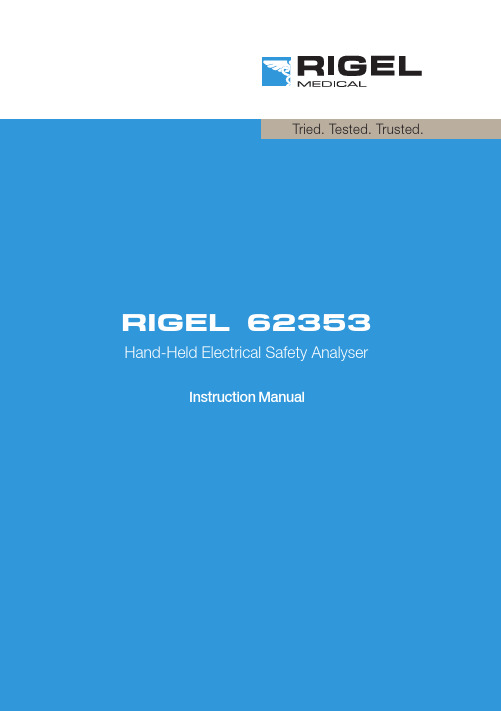
Tried.Tested.Trusted.Hand-Held Electrical Safety Analyser Instruction Manual 331A575Issue 1.0October 2009©2009Seaward Group Issue1.0RIGEL 62353symbol,1)Alpha Numeric keyboard,Up/Down and Left/Right cursor control.2)4Programmable soft keys below display3)Larger Green and Red key4)Full graphic Monochrone LCD,blue with white backlit,1/4VGA5)EUT socket to meet local requirements6)IEC input socket(IEC lead test)7)Custom detachable mains cable inlet8)2way Applied Part adapter box(see Appendix F for connection diagram)9)4mm Earth bond probe socket(Green)10)4mm Earth bond Auxiliary socket11)RS232connectionEscape Add Applied Copy Delete Edit Help Menu Home New OK Print Less Repeat Save Search Settings Single Shift Mute Soundpress theAvailable optionsTest Sequences Modify or create test sequences (see2.1) Asset Trace Variables Generate de(see2.2)f variablesf ault list oSequences menu,click on,press(F4).overview is provided a nd shows the list of defa ult Copied Test Sequences will appear in the list withtest sequence,sequence and press the button(F2).Arrow keys to select the required action and press the Press Escape(F3)to cancel and return to previous screen.from the Testthe(F4)the button(F4)will open the Tes t Sequenceand or Class of the Test Sequence,press the Buttonand or Class required.press the buttonpress the buttonpress the buttonchanges with the button(F3)or cancel using theDelete an individualpress the buttonback to the previous menu,the buttonmodify an individualpress the Buttonindividual TestPress the buttonsettings for;Test duration,field using the up and down keys.To changek eys or use the keypad to enter the correct press the buttonsettings have been achieved,press the button press (F3)for ever y test(F3)has been highlighted,confirm using the OKthe test Sequence.Pressing the button safety tests can be inserted o r deleted bybutton(F1)has been pressed,a drop down box tests and inspection available.Activate the drop down Custom Test option.the button(F4).The following menu will definesafety test(eg Equipment performance check at thefirst come first serve basis.To ins ert the new Cus tom Tes t,pres s thebutton(F3)and return to the previous screenthe button.the previous menyTest Sequenceby clicking on,press(F4). displays the list of default and customised tests available.appear in the list with an*pre-fix.From th s menu,user s able to create a new Test Sequencebutton–None-,the Test Sequence will only be set todetails.When the and appearTest Name,changethe buttonpress the buttonpress the buttonpress the buttonname oftheSequencePress the button Sequence has been opened,individual tests can where a new test needs inserting using thevariables can be added to the test results:settings on the Rigel62353include the Site and Location drop down box is set to[Yes].vate each var able,use the up and downthe buttonthe list as shown below;menu is displayed below;menu provides the following features: default language(see2.3.1)date(see2.3.2)Use the Left&Right Keys to set the date formatdd Month yyyy or mm/dd//yyyyUse the Left&Right Keys to set the time formatthe buttonthe buttonuser.Select a different user using the drop down menu or create a new user name by pressing the button(F1).Press button settings provided within the Setup menu will default to FactoryVariables,Test Sequences,User Admin and SystemFactory Settings cannot be undone andEnsure you have this information available when contacting Rigel Medical for Technical Support or Service.See chapter7.3for more information on Service and Calibration Procedures.for the Satety Test from the Asset Details screen; Asset ID number using the keypad(see3.1)down,left and right keys to select the requiredpress thehas the followingButtonboxes or free textWhen the con has been completed,press the button the button would return to the previous screen and lose theWhen the con figuration has been completed,press the button the button would return to the previous screen and losethe buttonnew Test SequencebuttonDown Keys to navigate the menu and the open the down boxes [<>].Select the required input automaticallythe buttoncorresponding appropriate button to select the outcome the earth bond test lead is connected to theprobe and EUT earth.the buttonnever connect the Earth Bond Probe to voltages can cause damage to the equipment.Warning Mains voltage applied to appliance.uses the Sem i Autom atic Mode and them om ent at which the leakage m easurem Rigel62353will start the measurements immediately on.The next step is to reverse the power supply. the power and start the test sequence again. determine when the measurements start.In instant and measurements will start directlyFollowing the safety tests,the user is able record such as performance of the medical electrical safety tests.h h h h biliPress the button(F4)to store the comments.can select any of the following options:provides the following features;home screen(F1)–ability to go to manual mode,the next test(F2)-Automatically brings up thethe buttonfollowing sub3.6View Resultsthe button(F2)to return to the Test Details screen.tests.a map showing where the individual tests can Manual Mode menu.Use the Up,Left and Right keys to navigate through the the button(F4)to confirm.centre of the analogue bargraph indicates the500μA)specifies thatThe buttonuser requirements.press the buttonthe buttonset the singlethe menuF1If an earth bond lead other than that supplied with the Rigel62353is to be used then any resistance associated with this lead be zeroed out by connecting the supplied earth bond lead to the EUT earth socket the Rigel62353and pressing the zeroPress buttonleft and rightbe calculated. overridden by selecting Press button complete.buttonPress the F1button to obtain the schematicthe maximum permitted voltage of30V AC/DCearth potential!Electric Shock danger!Press button250VDC)and Pass/Fail and right keys to PressSettings mode withoutF1buttonDo not exceed the maximum permitted voltage of30V AC/DC withrespect to earth potential!Electric Shock danger.This test is used to verify that the Applied Parts are adequately insulated from earth Press button250VDC)and Pass/FailPress the button the button Settings mode withoutF1buttonDo not exceed the maximum permitted voltage of30V AC/DC withrespect to earth potential!Electric Shock danger.This test is used to verify that the Applied Parts are adequately insulated from the Press button250VDC)and Pass/Fail right keys toPress the button the buttonSettings mode withoutPress the buttonnever leave the earth bond,or any other probe parts.never touch the appliance under testPress button Test Duration, arrow keys to Press the button the buttonPress the button。
尼通手持合金分析仪安全操作及保养规程

尼通手持合金分析仪安全操作及保养规程1. 引言尼通手持合金分析仪是一种用于快速和准确分析金属合金成分的便携式仪器。
为了确保仪器的正常运行和操作人员的安全,有必要制定一套操作和保养规程。
2. 安全操作在使用尼通手持合金分析仪时,请遵循以下指南:2.1 仪器准备•检查仪器是否完好。
确保仪器外壳无损坏,显示屏幕正常显示。
•接通仪器电源并检查电池电量。
如电量不够,应及时充电或更换电池。
•检查仪器是否校准。
如果仪器已超过校准期限,需要重新校准。
2.2 操作环境•在使用合金分析仪时,确保操作环境安全、干燥,远离可燃物和易爆物。
•避免在高温、高湿度或腐蚀性气体环境中使用。
这可能会影响仪器的性能和正常运行。
2.3 操作步骤•在操作之前请先阅读使用说明书,并按照指南操作。
•打开仪器电源并等待仪器初始化完成。
•使用仪器自带的清洁布清洁仪器的读取窗口,以确保测试准确性。
•根据被测试样品的类型选择正确的测试方法,并将样品置于仪器读取窗口上。
•启动测试程序,等待仪器测量完成。
•仔细阅读并记录显示屏上的测试结果。
同时,确保记录正确的样品编号等相关信息。
•在完成测试后,及时关闭仪器电源,并及时将相关数据导出或保存。
2.4 安全注意事项•使用过程中禁止随意拆卸或修改仪器任何部件。
•不要将仪器接触到水或其他液体中。
•避免将仪器暴露在过高的温度下,以免损坏仪器内部元件。
•避免长时间暴露在阳光直射下,以免导致仪器损坏。
•在使用仪器时,避免引线或电源线缠绕在身上,以防止发生意外。
3. 保养规程为了确保尼通手持合金分析仪的持久性能,以下保养规程需要按时执行:3.1 仪器清洁•在使用后,使用干净柔软的布轻轻清除悬挂在仪器上的灰尘和杂物。
•不要使用擦拭剂或化学溶剂直接喷洒在仪器上,以免损坏仪器表面。
3.2 存储与携带•在存储时,将仪器放置在干燥、通风、温度适宜的地方。
•避免将仪器存放在高温、高湿度或极端温度环境中。
•在携带仪器时,应使用仪器附带的防震包进行保护。
SPECTROXsort手持式光谱仪操作手册

SPECTR O Xsort手持式光谱仪操作手册1.注意事项1.分析样品必须是固态金属。
2.充满电的电池大约能持续使用3到3个半小时。
3.严禁对空分析。
4.仪器工作时枪头前10米内不能有人(包括10米距离上枪头中心点4米直径范围内)。
5.枪头保护套没有安装的情况下禁止分析。
6.分析过程中严禁触摸处于保护套范围内的样品区域。
7.在分析结束快门关闭前严禁脱离样品。
8.如果样品不能完全覆盖分析窗口,必须使用小样品夹具。
9.如果样品厚度小于5毫米,分析时不能手持样品。
2.如何开机并进入分析软件?1.开机前确认电池充电良好,电池正确的安装于仪器上。
2.打开电源(POWER)开关。
3.如果PDA没有自动打开,打开PDA,出现登陆界面。
如果没有出现登陆界面,在PDA中点击开始菜单S tart→XRF Analyzer CE即可进入分析软件。
4.输入登陆密码,进入软件。
3如何关机1.关闭电源(POWER)开关。
2.如果PDA没有自动关闭,关闭PDA。
4.如何做ICA L?每次打开仪器都要做一次I CAL,在等到冷却到稳定温度时进行。
如果光管关闭时间比较长,在继续进行测量之前也需要重新做I CAL。
点击按钮“Main Functi ons”,点击“ICAL”图标,ICAL自动进行,在此过程中你不需要做任何事情。
ICAL完成后将有确认信息:ICAL Succeeded, you can contin u e with you regula r measur ement now. 点击OK,ICAL完成。
仪器运行过程中会自动监控本身状态,如温度等.一旦发现变化,仪器会自动进行“Fast ICAL”,这时仪器自动对快门测量2秒并对I C AL进行检查并修正,但不会有任何提示信息.此过程结束后,可以继续进行正常工作.ICAL报告保存位置:_\XSort\ICAL\Log5 如何分析1.分析之前确认保护套正确安装;确认分析窗前只有分析样品并且分析样品正常的覆盖分析窗,如有必要,安装小样品夹具;确认保护膜没有污染、损坏。
合金分析仪安全操作规程
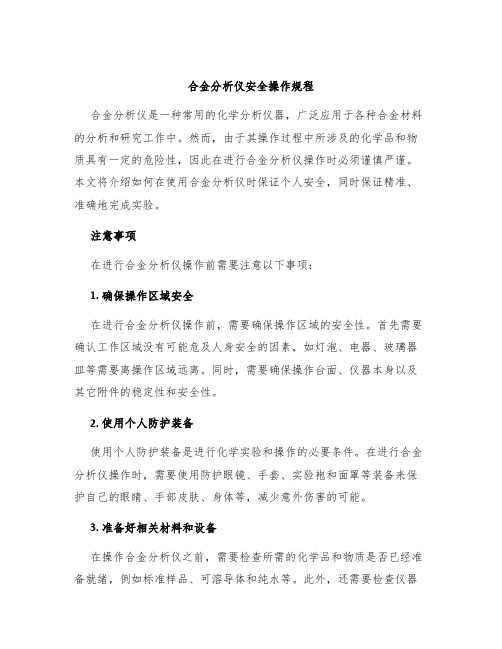
合金分析仪安全操作规程合金分析仪是一种常用的化学分析仪器,广泛应用于各种合金材料的分析和研究工作中。
然而,由于其操作过程中所涉及的化学品和物质具有一定的危险性,因此在进行合金分析仪操作时必须谨慎严谨。
本文将介绍如何在使用合金分析仪时保证个人安全,同时保证精准、准确地完成实验。
注意事项在进行合金分析仪操作前需要注意以下事项:1. 确保操作区域安全在进行合金分析仪操作前,需要确保操作区域的安全性。
首先需要确认工作区域没有可能危及人身安全的因素,如灯泡、电器、玻璃器皿等需要离操作区域远离。
同时,需要确保操作台面、仪器本身以及其它附件的稳定性和安全性。
2. 使用个人防护装备使用个人防护装备是进行化学实验和操作的必要条件。
在进行合金分析仪操作时,需要使用防护眼镜、手套、实验袍和面罩等装备来保护自己的眼睛、手部皮肤、身体等,减少意外伤害的可能。
3. 准备好相关材料和设备在操作合金分析仪之前,需要检查所需的化学品和物质是否已经准备就绪,例如标准样品、可溶导体和纯水等。
此外,还需要检查仪器所需的电源、连接线、软件和计算机等相关的设备和软件是否正常运行。
4. 遵循正确的操作流程在操作合金分析仪时,需要按照正确流程进行操作,严格按照液体、固体、易燃、毒性、腐蚀性等特性分类存放化学品,避免出现混淆,避免操作过程中出现问题。
5. 安全储存和处理化学品在进行合金分析仪操作时,需要使用化学品和物质。
在以后的实验过程中,需要注意储存和处理这些物品。
任何时间不要将化学品沿用原位留在实验室中,相反应将其按要求合理储存和处理。
操作流程下面是合金分析仪的操作流程:1. 开始开启合金分析仪电源和其它设备,并打开操作软件。
2. 准备实验物质取出所需的标准样品或待测物质,根据实验要求加入合适的容器中并与相关溶剂适量混合。
启动实验机。
3. 进行实验将所需实验物质注入合金分析仪中,启动操作过程。
根据所需数据要求进行测试,进行相关数据的收集和处理存储,打印报表。
手持式测试仪使用说明

手持式测试仪使用说明一.主要结构
A 电池(5节9伏,用户自配)
B 短路脱扣测试按钮
C 接地故障脱扣按钮
D 接地故障禁止按钮
E 热记忆禁止按钮
F 控制单元电源供应按钮
G9伏电池测试按钮
H 测试仪信号输入接口(10针)
I 2针测试电缆(STR)
J 10针测试电缆(Micrologic)
二.连接步骤
1.连接10针接头(A)到测试仪10针接口
2.连接2针接口(B)到NS断路器STR脱扣器3.或连接7针接口(B)到MT断路器Mic控制单元
三.短路测试步骤
1.确保主回路没有负荷后,断路器合闸
2.按短路测试按钮(A)
3.对NS STR脱扣器,测试仪上的短路红色LED指示灯亮表示测试在过程中对MT Micrologic控制单元,红色LED指示灯闪烁指示测试在过程中
4.通过判断是否断路器脱扣可知测试是否成功。
5.如果短路脱扣测试成功结束,红色短路脱扣指示灯将自动熄灭,而不会有错误指示。
四.接地故障测试
接地故障测试适用于STR53脱扣器和
Micrologic 6.0A,P,H型控制单元。
步骤同短路测试步骤,按接地测试按钮即可。
五.禁止接地故障保护和热记忆功能
通过按禁止接地故障保护或热记忆按钮,可在测试仪连接在脱扣器上时禁止脱扣器的接地故障保护或热记忆功能。
六.给控制单元供电
可通过测试仪为Micrologic控制单元供电,使液晶屏显示以便于观察和设置。
七.测试仪电池检测
可检验测试仪的电池电压是否正常
-绿灯亮表示电池正常
-红灯亮表示电池容量不足
-都不亮表示电池没有电或未装电池。
手持合金分析仪的操作方法
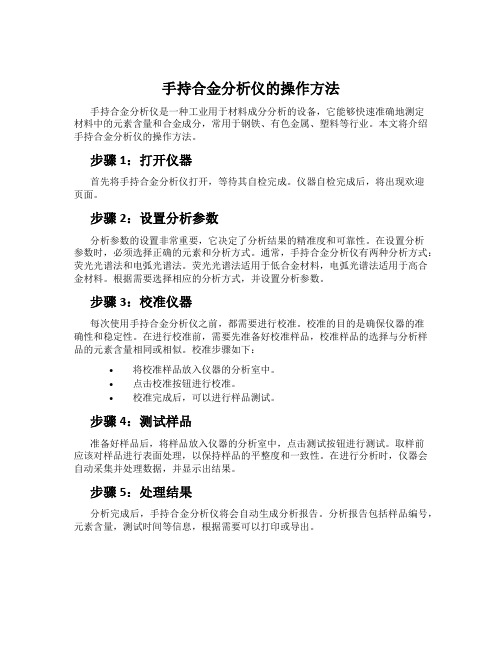
手持合金分析仪的操作方法手持合金分析仪是一种工业用于材料成分分析的设备,它能够快速准确地测定材料中的元素含量和合金成分,常用于钢铁、有色金属、塑料等行业。
本文将介绍手持合金分析仪的操作方法。
步骤1:打开仪器首先将手持合金分析仪打开,等待其自检完成。
仪器自检完成后,将出现欢迎页面。
步骤2:设置分析参数分析参数的设置非常重要,它决定了分析结果的精准度和可靠性。
在设置分析参数时,必须选择正确的元素和分析方式。
通常,手持合金分析仪有两种分析方式:荧光光谱法和电弧光谱法。
荧光光谱法适用于低合金材料,电弧光谱法适用于高合金材料。
根据需要选择相应的分析方式,并设置分析参数。
步骤3:校准仪器每次使用手持合金分析仪之前,都需要进行校准。
校准的目的是确保仪器的准确性和稳定性。
在进行校准前,需要先准备好校准样品,校准样品的选择与分析样品的元素含量相同或相似。
校准步骤如下:•将校准样品放入仪器的分析室中。
•点击校准按钮进行校准。
•校准完成后,可以进行样品测试。
步骤4:测试样品准备好样品后,将样品放入仪器的分析室中,点击测试按钮进行测试。
取样前应该对样品进行表面处理,以保持样品的平整度和一致性。
在进行分析时,仪器会自动采集并处理数据,并显示出结果。
步骤5:处理结果分析完成后,手持合金分析仪将会自动生成分析报告。
分析报告包括样品编号,元素含量,测试时间等信息,根据需要可以打印或导出。
总结手持合金分析仪是一种快速便捷的分析设备,使用时需要注意几个关键步骤:打开仪器、设置分析参数、校准仪器、测试样品、处理结果。
正确的使用手持合金分析仪可以提高工作效率,准确度和稳定性。
分析仪器操作规程

分析仪器操作规程
《分析仪器操作规程》
分析仪器在科研、实验室和工业生产中扮演着重要的角色,可用于分析样品中的物质成分、结构和性质。
在使用分析仪器时,正确的操作规程是非常重要的,不仅可以保证测试结果的准确性和可靠性,还可以确保操作者的安全。
首先,操作者需要在使用前仔细阅读仪器的操作手册,了解仪器的基本原理、性能参数和操作步骤。
在操作过程中,应该严格按照手册上的要求进行操作,不得随意更改仪器的设置或参数。
其次,操作者应该做好仪器的准备工作,包括检查仪器是否处于正常工作状态、样品是否准备就绪,以及必要的安全措施是否已经采取。
在操作过程中,应当严格按照操作规程进行操作,确保每一个步骤都得以正确执行。
另外,操作者需要定期检查和维护仪器,保证仪器的正常运行。
在发现问题时,应立即停止使用并进行维修和调整。
操作者还需要定期参加仪器操作培训,了解最新的操作规程和技术要求。
最后,操作者在使用分析仪器时需要严格遵守相关的安全规定,正确佩戴个人防护设备,并遵守实验室的相关规定。
在操作过程中,应该保持专注,严禁喧哗和嬉戏,确保操作的准确性和安全性。
总之,正确的操作规程是使用分析仪器的基础,操作者需要严
格遵守操作规程,确保仪器的正确使用和测试结果的准确性。
同时,也需要时刻关注仪器的维护和安全,保障操作者的安全和实验室的安全。
手持式光学仪器用户手册说明书

Product DescriptionThe ergonomically designed imager houses the imaging optics, detector, drive electronics, optical modulator,laser pointer and four standard or rechargeable AA size batteries. The system includes an optional pistol grip handle which holds virtually any ‘Pocket PC’or compatible ‘Palm’device as a combined processing, display unit and image storage device. As an alternative, the output of the imager can be displayed and processed in real time using a PC.OperationThe system is designed for either one or two handed operation. For one handed operation both the imager and the user provided ‘Pocket PC’/ ‘Palm’device can be attached to the handle to form a single integrated lightweight unit. For two handed operation the imager can be quickly detached from the handle leaving the ‘Pocket PC’/ ‘Palm’device attached for ease of operation. This latter configuration enables the imager to be pointed at awkward angles or used in confined places. Alternatively, instead of using a ‘Pocket PC’/ ‘Palm’device the imager can be linked to a PC or laptop computer using the RS232 serial cable supplied.Dec 2004IPU 40055 issue 3IRI 1011Universal Thermal ImagerThe IRI 1011 is a groundbreaking thermal imager product which brings the benefits of this versatile technology to the professional, the trades person and the non-specialist alike.The flexibility, ease of use and above all, the low cost of this product extend the normal application areas for thermal imaging from military and professional use, to wider use in industrial,commercial and domestic applications .Typical applications for the IRI 1011 include:Predictive and Preventative MaintenanceProcess MonitoringResearch and Development HV AC Troubleshooting Vehicle MaintenanceGeneral Industrial/Domestic......ABDWorld Leaders inArray-Based DetectorsThe IRI 1011 Universal Thermal ImagerPERFORMANCETemperature Measurement range:-10˚C to +300˚C Field of view (FOV):20˚x 20˚Spectral Response:8 to 14 micrometers Sensitivity:~0.3K @ 30˚C Displayed Image:96 x 96 pixels Detector:16 x 16 pixel array Frame rate:8HzIMAGE STORAGEUp to 1000 images per MB of SER POINTERA built in Class II laser is supplied to highlight the reference pixel.IMAGER POWER SUPPLYBattery:4 x AA type removable batteries.Lithium cells are recommended for operation at low temperatures.Operation time:Up to 8 hours.AC operation:AC adaptor, supplied.MECHANICALHousing: Impact Resistant Plastic.Dimensions: 120mm x 125mm x 80mm.Weight:< 600g not including ‘Pocket PC’/‘Palm’device and handle.Mounting: Handheld & Tripod mounting.IRI 1011 INCLUDESImager, software for ‘Pocket PC’, ‘Palm’& PC, 2m RS232 connection cable - imager to PC, user manual, AC power supply, carrying case.OPTIONA pistol grip handle for attaching imager and ‘Pocket PC’/ ‘Palm’Device for single handed operation.SPECIFICATIONABDWorld Leaders inArray-Based DetectorsInfraRed Integrated Systems Ltd, Towcester Mill,Towcester, Northants, NN12 6AD, UK Telephone:+44 (0) 1327 357824Fax:+44 (0) 1327 357825e-mail:***************.uk web site:Whilst IRISYS endeavour to ensure that all descriptions, weights, temperatures, dimensions and other statistics contained in this product information are correct, they are intended to give a general idea of the product only and IRISYS do not warrant their accuracy or accept liability for any reliance on them. IRISYS have a policy of continuous product improvement and reserve the right to change the specification of the products and descriptions in this data sheet. Prior to ordering products please check with IRISYS for current specification details. This product is protected by patents EP 0 853 237 B1 and US 6,239,433 B1. Other patents pending.All brands and product names are acknowledged and may be trademarks or registered trademarks of their respective holders.ENVIRONMENT Temp. operating range:-5˚C to +50˚C Humidity:10% to 90% non condensing Temp. storage range:-20˚C to +80˚CCE Mark (Europe):Complies with EMC directiveSETTINGS AND CONTROLS:User selectable sensitivity er selectable offset control (range).Auto adjust sensitivity/range.Display palettes: red/blue, green/blue and greyscale.‘Pocket PC’/ ‘Palm’device: two moveable temperature measurement cursors.PC: up to ten moveable temperature measurement cursors.User selectable emissivity values.User selectable image integration: 1 to 10 frames.Readout in ˚C, ˚F and K.Image snapshot.Image label.FEATURES - ‘POCKET PC’/ ‘PALM’SOFTWAREReal time image and temperature measurement display Multiple image storage and retrieval.Image browser.Battery Charge indicator‘Pocket PC’/ ‘Palm’device controlled by navigator button and touch sensitive screen controls. Reflected ambient temperature compensation.Temperature difference measurement.FEATURES - PC SOFTWAREMultiple image storage and retrieval.Time / Temperature display for up to ten user defined pixels.Save all 256 temperature values to Microsoft Excel.Copy & Paste images into other Microsoft applications.Reflected ambient temperature compensation.Real time image and temperature measurement displayCOMPUTER REQUIREMENTSPocket PC: Compatible with most ‘Pocket PC’devices running Microsoft ‘Pocket PC’2000, 2002 and 2003. e.g. HP iPAQ 2210, O2 XDA - (See IRISYS website for compatible Pocket PC’s). RS 232 to ‘Pocket PC’communication cable or CompactFlash RS 232 adaptor where applicable.Palm :Palm devices conforming to OS5 or higher, double density screen, 320 x 320 display resolution.eg. Palm Zire 71, Palm Tungsten T3. (See IRISYS website for compatible Palms)PC :IBM compatible PC with a minimum of:300MHz processor, MS Windows 2000 and XP (see IRISYS website for current list of operating systems supported). RS 232 serial port (115k Baud),16 bit colour graphics capability.........................CAUTIONCLASS II LASER PRODUCT635nm 0.9mW。
手持式合金分析仪安全操作及保养规程
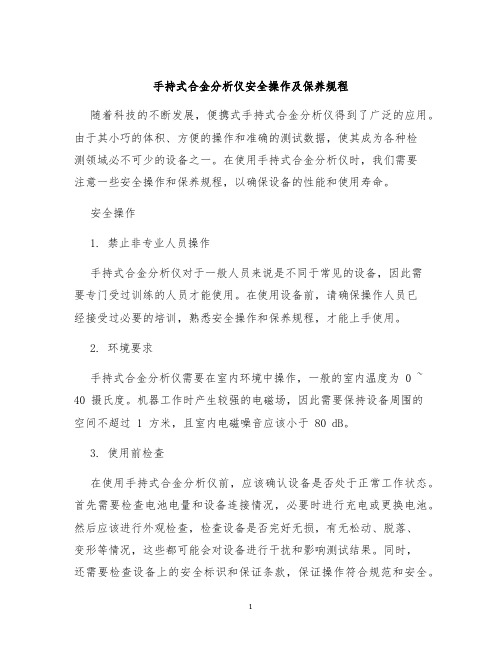
手持式合金分析仪安全操作及保养规程随着科技的不断发展,便携式手持式合金分析仪得到了广泛的应用。
由于其小巧的体积、方便的操作和准确的测试数据,使其成为各种检测领域必不可少的设备之一。
在使用手持式合金分析仪时,我们需要注意一些安全操作和保养规程,以确保设备的性能和使用寿命。
安全操作1. 禁止非专业人员操作手持式合金分析仪对于一般人员来说是不同于常见的设备,因此需要专门受过训练的人员才能使用。
在使用设备前,请确保操作人员已经接受过必要的培训,熟悉安全操作和保养规程,才能上手使用。
2. 环境要求手持式合金分析仪需要在室内环境中操作,一般的室内温度为 0 ~ 40 摄氏度。
机器工作时产生较强的电磁场,因此需要保持设备周围的空间不超过 1 方米,且室内电磁噪音应该小于 80 dB。
3. 使用前检查在使用手持式合金分析仪前,应该确认设备是否处于正常工作状态。
首先需要检查电池电量和设备连接情况,必要时进行充电或更换电池。
然后应该进行外观检查,检查设备是否完好无损,有无松动、脱落、变形等情况,这些都可能会对设备进行干扰和影响测试结果。
同时,还需要检查设备上的安全标识和保证条款,保证操作符合规范和安全。
4. 样品准备在进行样品测试前,需要对样品进行准备处理。
一般需要将样品表面进行磨削、去污等处理,以便于从表层得到较准确的元素浓度,避免深度测量而引起误差。
5. 测试精度手持式合金分析仪测量精度是与测试深度和元素浓度相关的,因此在测试前需要了解测试样品的成分和测量精度要求,以便于选择测量模式并进行测量,同时需要保证测试样品的平稳和稳定性,以避免因采样不均匀造成的误差。
6. 测量操作在测量过程中,需要将测试头紧密地与样品表面接触,以提高测试精度,在测试过程中需要注意不要晃动测试头和设备本身,同时要避免样品被检测过程中产生静电等影响,保证测量结果的准确性。
在测量过程中需要严格按照设备说明书所列的测量流程操作,避免因个人操作不当,而影响测试精度和设备寿命。
合金分析仪安全操作规程

合金分析仪安全操作规程合金分析仪是一种很重要的分析测试仪器,其主要作用是检测化合物的组成,以便确定其质量和化学特性。
由于其使用过程中涉及到较多的化学物质和特殊的安全要求,因此合金分析仪的安全操作规程十分重要。
以下是合金分析仪安全操作规程的内容。
一、设备准备1.设备摆放:合金分析仪应放在干燥、通风良好、光线充足的场所,仪器周围应保持清洁。
2.仪器检查:使用前要检查合金分析仪是否完好无损,在使用过程中,需要进行定期检查和维护,保证安全可靠。
3.化学试剂:使用化学试剂前要详细了解其性质,注意不同试剂之间的相互作用,尽量避免混用不同品种的化学试剂。
二、个人防护1.佩戴防护用品:使用合金分析仪时,要佩戴防护眼镜、防护手套和防护面罩等个人防护用品,保护自己的视力和呼吸系统。
2.防护姿势:在对样品进行处理或测试过程中,尽量不要与其密切接触,保持一定距离,防止样品中的化学物质对身体造成危害。
3.安全意识:在使用过程中,要时刻保持安全意识,如果使用过程中出现任何异常情况,应立即停止操作,并寻找故障原因进行排查。
三、仪器操作1.样品准备:在使用前要准备好样品,将样品放入样品台,调整好波长和功率,保证测试结果正确提取。
2.化学试剂的使用:在使用化学试剂时,需要按照相关要求,使用正确的试剂,并遵守正确的化学物品管理方法和处理流程。
3.仪器维护:在使用合金分析仪之后,一定要对仪器进行良好的维护和保养,包括对仪器进行清洁和消毒,并对检测结果进行存储和分析。
合金分析仪的安全操作规程是使用该仪器过程中非常重要的方面,使用者必须认真遵守以上要求,保证使用过程安全可靠,同时必须对使用环境进行彻底的卫生消毒,以确保化学物品无害化。
手持测量工具安全操作规程(完整版)

手持测量工具安全操作规程(完整版)1. 引言本文档旨在确保员工在使用手持测量工具时能够安全操作,并减少事故和伤害的风险。
以下是手持测量工具的安全操作规程。
2. 操作前的准备在使用手持测量工具之前,请确保您具备以下知识和技能:- 熟悉手持测量工具的使用方法和技巧。
- 了解手持测量工具的规格和功能。
- 掌握正确的测量方法。
3. 工具检查每次使用手持测量工具之前,请进行以下检查:- 确保手持测量工具的外观完好无损,没有明显的损坏或缺陷。
- 检查测量刻度和标记是否清晰可见。
- 检查测量工具的动作部件是否灵活,无卡滞或松动。
4. 安全操作要点在使用手持测量工具时,请遵循以下安全操作要点:- 使用正确的手持测量工具进行相应的测量任务,不要临时改变或替代工具。
- 确保手持测量工具与被测量物体保持平稳接触,避免晃动或偏离测量目标。
- 使用适当的手势和力量进行测量,不要使用过大或过小的力量。
- 在进行测量时,避免手持测量工具与周围物体碰撞或摩擦,以免损坏工具或造成伤害。
- 如果手持测量工具需要调整或校准,请按照指定的方法进行操作,并及时报告异常情况。
5. 操作结束后的处理在使用手持测量工具完成测量任务后,请进行以下处理:- 将手持测量工具放置在指定的存放位置,避免接触湿气、高温或腐蚀性物质。
- 清洁手持测量工具的表面,并在需要时使用适当的润滑剂进行维护。
- 在不使用手持测量工具时关闭电源或拔下电源线,以节省能源并确保安全。
6. 紧急情况处理在出现紧急情况时,请立即采取以下措施:- 停止使用手持测量工具。
- 避免直接接触可能存在危险的部分。
- 寻求上级或专业人士的帮助,并及时报告相关的事故或伤害。
7. 监督和培训公司将负责对员工进行手持测量工具的安全操作培训,并定期进行监督和检查。
员工应按照培训要求进行操作,并随时提出疑问或建议。
结论本文档详细描述了手持测量工具的安全操作规程,包括操作前的准备、工具检查、安全操作要点、操作结束后的处理、紧急情况处理以及监督和培训。
便携式合金测试仪安全操作及保养规程

便携式合金测试仪安全操作及保养规程一、安全操作1.1 使用前的准备1.确认测试仪部件完好无损,特别是探头是否完好。
2.仪器内部检查:开盖时,先检查内部电源连接是否正常,仪器内部有无杂物等。
若发现什么问题请勿擅自拆卸仪器,应当联系专业人员进行维修。
3.检查电源电压是否与仪器要求的标称电压相符。
不相符时请勿使用仪器。
1.2 测试操作1.手持测试仪,将探头平稳地放置在待测合金表面,按下探头上方的按钮,等待测试仪读出合金成分数据。
2.测试仪的探头与测试对象的接触面要光滑平整,要确保不出现空隙、腐蚀等情况,否则会影响测试结果。
3.操作完成后,请按下停止按钮,确保测试数据已经保存。
1.3 注意事项1.使用过程中应防止大力碰撞和摔落,避免对仪器造成损坏。
2.在探头不使用时,请勿将探头暴露在空气中。
此时需加盖保护,避免氧化、氢脆等问题。
3.测试仪的电源线不要与其它电源线搭配使用,避免损坏电路。
二、保养规程2.1 保养周期1.日常保养:每次使用后,应将测试仪外表面、防护盖等部位清洁干净。
2.定期保养:测试仪应每年通过专业机构检查,保证其正常使用。
2.2 保养步骤1.清洁:使用干净的布擦拭仪器外表面,防止灰尘污垢等物质侵蚀仪器。
2.探头抛光:每隔一段时间需要对探头进行抛光处理,充分发挥其使用寿命和准确率。
3.更换配件:如发现有配件受损或者电池容量减少等情况,需要及时更换以确保仪器的正常使用。
2.3 存放与运输1.存放:测试仪在存放过程中应使用专属防护盒保护,避免阳光、雨雪、潮湿等情况对仪器造成损害。
存储环境的温度应在-15℃~40℃之间。
2.运输:测试仪在运输过程中应采用专用保护材料,避免碰撞和振动等情况对仪器造成损害。
三、总结便携式合金测试仪在使用过程中一定要注意安全操作,遵循正确的操作规程,同时定期进行维护保养,这样才能确保它的正常使用寿命。
手持式合金分析仪操作规程(中英文)

手持式合金分析仪操作规程Operating regulation for handy-alloy analysis一、范围1. Range本规程适用于厂内型号为Niton XLT898W手持式合金分析仪的使用操作。
This operating regulation is applied for handy-alloy analysis in HBG named Niton XLT898W.二、工作原理及适用范围:2. Working principle and scope of application采用X射线荧光(XRF)技术进行多元素分析。
用于各种高低合金钢、不锈钢、工具钢、铬/钼钢、镍合金、钴合金、镍/钴耐热合金、钛合金、铜合金等,可分析Ti V Cr Mn Fe Co Ni Cu Zn Nb Zr Mo Ag Pd Sn Hf Ta W Re Pb Bi Se Sb 等元素。
Using fluorescent X-ray technology to have multi-element analysis. this devie is applied for kinds of alloyed steel, non-corrosive steel, tool steel, chrome-molybdenum steel, nickel alloy, cobalt alloy, nickel/cobalt heat-resisting alloy, titanium alloy, copper alloy and so on. it can also analysis kinds of elements like Ti V Cr Mn Fe Co Ni Cu Zn Nb Zr Mo Ag Pd Sn Hf Ta W Re Pb Bi Se Sb.三、工作条件:3.Working condition工作温度:-20℃-50℃;样品温度:0℃-50℃。
光谱仪使用
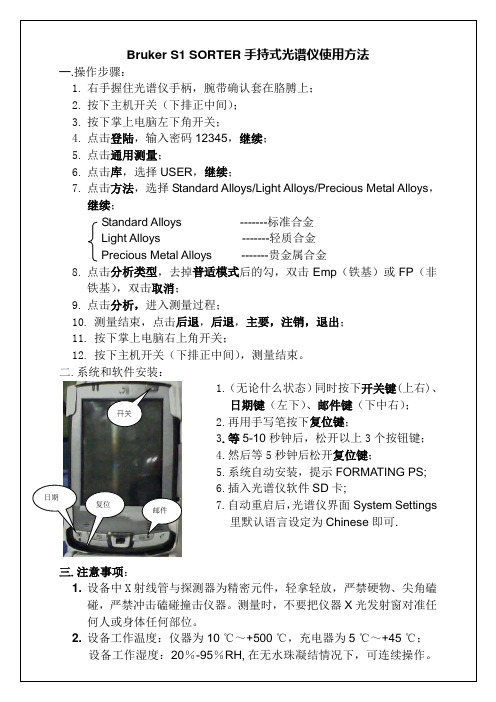
房延红
2011-05-23
Standard Alloys -------标准合金
Light Alloys -------轻质合金
Precious Metal Alloys -------贵金属合金
8.点击分析类型,去掉普适模式后的勾,双击Emp(铁基)或FP(非铁基),双击取消;
9.点击分析,进入测量过程;
10.测量结束,点击后退,后退,主要,注销,退出;
11.按下掌上电脑右上角开关;
12.按下主机开关(下排正中间),测量结束。
二.系统和软件安装:
1.(无论什么状态)同时按下开关键(上右)、日期键(左下)、邮件键(下中右);
2.再用手写笔然后等5秒钟后松开复位键;
5.系统自动安装,提示FORMATING PS;
Bruker S1 SORTER手持式光谱仪使用方法
一.操作步骤:
1.右手握住光谱仪手柄,腕带确认套在胳膊上;
2.按下主机开关(下排正中间);
3.按下掌上电脑左下角开关;
4.点击登陆,输入密码12345,继续;
5.点击通用测量;
6.点击库,选择USER,继续;
7.点击方法,选择Standard Alloys/Light Alloys/Precious Metal Alloys,继续;
6.插入光谱仪软件SD卡;
7.自动重启后,光谱仪界面System Settings里默认语言设定为Chinese即可.
三.注意事项:
1.设备中X射线管与探测器为精密元件,轻拿轻放,严禁硬物、尖角磕碰,严禁冲击磕碰撞击仪器。测量时,不要把仪器X光发射窗对准任何人或身体任何部位。
- 1、下载文档前请自行甄别文档内容的完整性,平台不提供额外的编辑、内容补充、找答案等附加服务。
- 2、"仅部分预览"的文档,不可在线预览部分如存在完整性等问题,可反馈申请退款(可完整预览的文档不适用该条件!)。
- 3、如文档侵犯您的权益,请联系客服反馈,我们会尽快为您处理(人工客服工作时间:9:00-18:30)。
手持式合金分析仪操作规程Operating regulation for handy-alloy analysis一、范围1. Range本规程适用于厂内型号为Niton XLT898W手持式合金分析仪的使用操作。
This operating regulation is applied for handy-alloy analysis in HBG named Niton XLT898W.二、工作原理及适用范围:2. Working principle and scope of application采用X射线荧光(XRF)技术进行多元素分析。
用于各种高低合金钢、不锈钢、工具钢、铬/钼钢、镍合金、钴合金、镍/钴耐热合金、钛合金、铜合金等,可分析Ti V Cr Mn Fe Co Ni Cu Zn Nb Zr Mo Ag Pd Sn Hf Ta W Re Pb Bi Se Sb 等元素。
Using fluorescent X-ray technology to have multi-element analysis. this devie is applied for kinds of alloyed steel, non-corrosive steel, tool steel, chrome-molybdenum steel, nickel alloy, cobalt alloy, nickel/cobalt heat-resisting alloy, titanium alloy, copper alloy and so on. it can also analysis kinds of elements like Ti V Cr Mn Fe Co Ni Cu Zn Nb Zr Mo Ag Pd Sn Hf Ta W Re Pb Bi Se Sb.三、工作条件:3.Working condition工作温度:-20℃-50℃;样品温度:0℃-50℃。
Working temperature: -20℃-50℃;specimen temperature: 0℃-50℃.四、被测金属样品的外形尺寸:4.outline dimension of measured metal specimen线材:直径1mm以上;小口径管材:外径2mm以上;被测材料与探测窗之间的距离小于10mm;被测材料(表面)的状态:平面、曲面、粗糙表面、不规则表面、粉末状、振动状态等。
被测表面应打磨露出金属光泽,不影响分析结果。
Wire stock: diameter greater than 1mm;Small pipe-tube: external diameter greater than 1mm;Distance between measured material and detecting window less than 10mm;Status of measured material(surface):flat face, curved face, rough face, irregular face, pulverous face, vibrate face and so on, measured material surface should be shined until the material appear metal brightness and not effect on analysis result.五、操作步骤:5.Operation procedure:1.使用前认真阅读本设备操作使用规程或使用说明书,仔细检查仪器表面,如发现有明显破损或异常现象应立即更换。
2.使用该设备时应正确佩戴设备防护腰带,手握设备时应先把防滑带套入手腕,以防设备损坏。
3.测量前应保证被测面露出金属光泽。
按下电源开关,仪器发出提示音,液晶屏幕显示数据后,直接在触摸屏上输入1、2、3、4、E进入操作界面(主界面)。
4.仪器校正:在正式测试前,应检测“标块”,确认检测值正常,方可进检测产品。
5.测量时把发射镜贴近被测物体表面,按下把手上的检测开关按钮,此时工作提醒灯闪烁测量开始,待仪器发出提示音测量结束。
6.按“▼”/“▲”键翻看检测数据。
继续检测请则再次按下把手上的检测开关按钮。
退出检测界面按“←”回到主界面。
7.测量完毕后长按电源开关,关机,并将设备放置在防水设备箱内。
1. Reading the operation standard or operation instruction of this device carefully beforeusing, examining the device surface carefully, Replacing the device immediately if any abnormal phenomenon or breakage was found.2. Wearing device proofing girdle before using, antiskid belt should be grabbed in wrist whengrab the device in case of damaging.3. Metal brightness should be appeared before measurement. Pressing the battery button, thenthe device come out a present sound. After the liquid crystal screen manifests record, press 12 3 4 E in the touch screen to get in operation interface.4. Device adjustment: before formal testing, testing block should be tested, the productshould not be testing until the record was normal.5. The detective window should near the measured product surface when the measurement isbegin, press the detecting button in grip, when working light is flashing the measurement begin, it is over when the device comes out sound.6. Pressing “▼”/“▲”to observe detection record. Pressing the detecting button again if youwant to continue detection. Pressing “←”to quit detection interface.7.Holding on pressing power button when measurement was complete, and the device shouldbe located in water-proof instrument case.六、注意事项:6. matters needed attention:1.本仪器需专人操作,专人负责日常维护、清洁及保养工作,并做好仪器使用记录。
非相关人员不得擅自操作。
2.操作前应确保电池有足够电量。
3.在任何时候都要确定X射线方向、谨防辐射。
4.在任何情况,如果未使用仪器,不得开启挡板。
5.在测试过程中不得将仪器放在Kapton窗口附近。
在挡板开启时,勿将仪器指向自己或其他任何人。
6.在下载读数时不可进行测量,在删除数据时切勿关闭仪器。
7.勿将仪器侵入水中。
8.本仪器因采用X射线荧光,因而要避免在露天强光(特别是紫外线强的前提下)操作,以免数据不准。
9.本仪器为精密设备,操作时尽量做到轻拿轻放,以免设备破损。
1.This device need specialized operator and specialized individual to maintain, cleaning daily,Device record should be written down and other people without permission should not use this device.2. Ensure enough battery before operation.3. Ensure the derection of X-ray whenever using it. Being aware of radiation.4. Under any circumstance, baffle must not be opened if the device was not used.5. The device should not located near the Kapton window during the testing phase. Whenbaffle is open, the device should not opoint to youself or others.6.No testing when the record is downloading and No shutting down the device when deletingthe record.7. The device should not immerse into water.8. Own to the device using X-ray, the device should avoid out-door operation(especially inthe day when ultraviolet ray is high),in case of inaccuracy record.9. This device is a precise instrument, when operating it should place softly in case ofdamage.七、其他关于仪器的工作原理、保养、故障排除等内容请参阅具体说明书或联系设备厂家。
7. Other information about the working principle, maintainance, failure recovery and so on should be found in the instruction or factory which product this device.。
